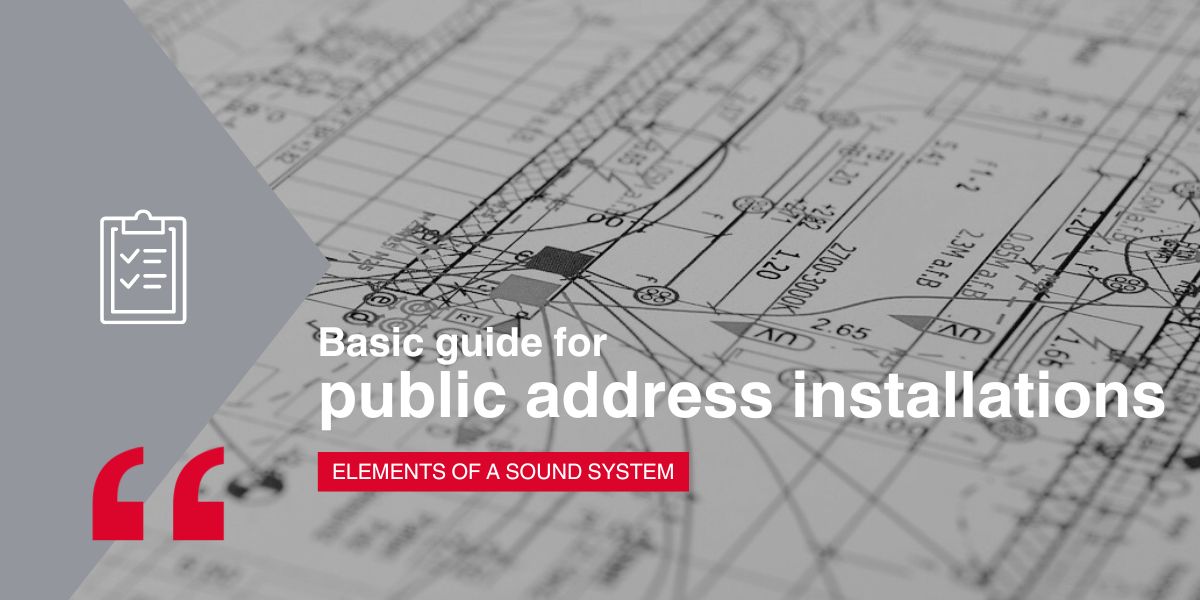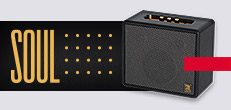Any sound system, from the most basic to the most complex, consists of the following elements:
- Signal source, which generates an electrical audio signal. This signal can be a phono or turntable level signal [of the order 0.5-2 mV], a microphone [of the order 7-10 mV], or a line level signal [of the order 150 mV–5V].
- Amplifier, which adapts the electrical audio signal from the sources, mixes them and gives the output a single signal. The amplifier consists of a preamplifier, which performs the mixing, and a power stage, which performs the amplification.
- Speakers, which convert the electrical signal generated by the amplifier into an acoustic signal that is emitted into the audience area.
Knowing the customer’s needs in terms of speech, music, microphones, etc. is essential for selecting the most suitable models of signal sources (microphones, players, etc.), amplifiers and speakers.

Microphones
The microphone is one of the most important components of the device and can improve or decrease the effi ciency of an installation. In general there are two families of microphones: Dynamic and condenser. The main difference is that condenser microphones are more sensitive, have a better signalto-noise ratio and require a battery or phantom power to supply the preamplifi er of the condenser capsule, which is smaller than the dynamic microphone.
Microphones deliver very weak electrical signals (in the order of 7-10 mV), and any noise picked up by the cable easily interferes with the signal. To avoid these problems, 80% copper shielded cable (minimum) with one or two conductors is used, depending on whether the signal is balanced or unbalanced.
One problem that can occur with microphones is acoustic feedback, which is caused by the proximity between microphones and loudspeakers in an audio installation. The sound picked up by the microphone and emitted by a loudspeaker is picked up again by the microphone and amplifi ed again, generating a feedback loop that eventually saturates the amplifier and produces the so-called feedback whistle, usually at certain frequencies. The solution is to vary the microphone and speaker location, properly equalise the audio signal or install a feedback suppressor that cancels feedback.
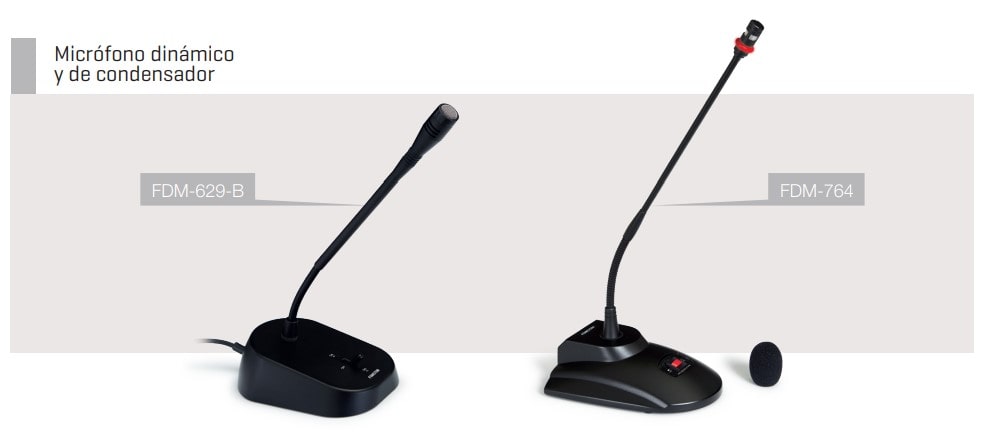
Amplifiers
The amplifiers incorporate a preamplifier and a power stage. The extensive range of FONESTAR amplifiers covers the widest range of possibilities. In small and medium-sized installations, an amplifier is responsible for managing the system inputs/ outputs. In larger and more complex installations, the amplifer can be part of a zone system managed by an advanced control unit.
The most notable features that an amplifier can incorporate are as follows:
- Music sources: Several FONESTAR amplifier models have a USB/SD/MP3/Bluetooth player or AM/FM digital tuner. This feature makes them extremely versatile for a multitude of installations, enabling them to reduce costs on additional devices.
- Priority: This is normally applied to give announcements and communications via microphone. The priority function automatically attenuates the volume of the background music or auxiliary inputs when a signal is detected at the microphone input with priority or a contact closure occurs, depending on the model.
- Priority 24V system: Some equipment allows paging announcements to be made at maximum volume in areas controlled by attenuators (volume controllers) even when the attenuators are at low volume or turned off.
Zone volume control: Some computers allow independent volume control of 2 or more speaker zones. - Microphone inputs with associated preamplifier: For greater fl exibility of operation, the microphone inputs can be connected simultaneously and mixed, controlling the volume of each one of them. According to model, they have unbalanced and balanced inputs according to the following diagrams:
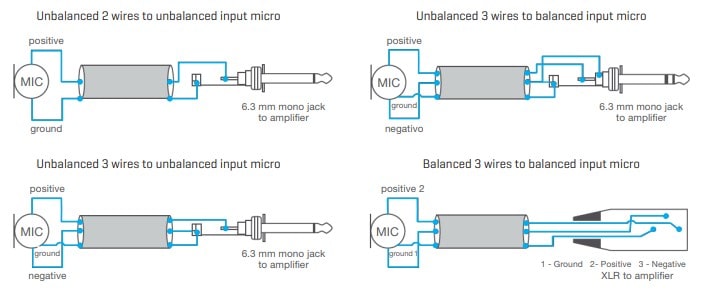
The balanced signal is transmitted via a three-wire cable (positive, negative and shield). The positive pin outputs the signal and the negative pin outputs the inverted signal. Electro-magnetic interference which is not rejected by the shielding of the cable will affect the two conductors carrying the signal in the same way.
The balanced input performs the unbalancing, i.e. it inverts the negative signal and adds it to the positive signal, thus “doubling” the original signal and cancelling the interference produced in the cable. Balanced connections are known as “professional” connections, as they are resistant to electromagnetic interference and can withstand long cable runs.
A typical FONESTAR amplifier input is a combo input, which allows the use of XLR or 6.3 mm Jack connectors. It also incorporates a selector to choose between dynamic microphone, condenser microphone and line level input.
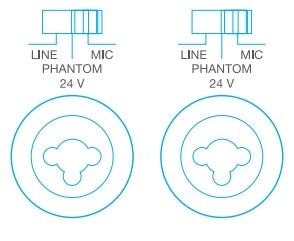
- Phono inputs: Phono inputs allow you to connect a turntable with low signal level output (on the order of 0.5 mV-2 V).
- Euxiliary Inputs: The auxiliary inputs allow you to connect a sound source with a high signal level output (on the order of 150 mV-3 V). Normally, FONESTAR amplifi ers incorporate 2 x RCAs inputs.
- Auxiliary Output: Can be used for recording by connecting a device to this output, or to connect to another amplifi er to increase the total power of the system.
Speakers
It is very important to determine the room sound requirements of an installation in order to select the most suitable type(s) of speaker(s) for the installation. In closed rooms, the characteristics of the premises make the installations vary enormously: ceiling height, surface of the room, materials, coverings, noise level, etc., make it necessary to be careful in the choice and distribution of the speakers. Before proceeding with the installation it will be necessary to consider:
- Room configuration: Desired sound level and quality to select the type of speaker to use: Haging sphere, column, projector, surface speaker, ceiling speaker, etc. It is not the same to cover a venue for background music as it is for voice announcements.
- Distance between amplifier and speakers.
- Number of speakers depending on whether the installation is high or low impedance.
- Reverberation of the premises and ambient noise. Determine the need to install more or less speakers and the location of the speakers. In very reverberant and noisy premises, more sound points will have to be distributed, so that all the audience is placed within the direct radiation of at least one speaker. Or use speakers that allow configurable directivity patterns.
The regular distribution of loudspeakers should provide a constant sound level throughout the listening area. Reflections that cause the spoken message to be unintelligible should be avoided.
The ceiling speaker is a generally valid solution for any room, provided that the ceiling height is not excessive (maximum 4 meters). To calculate the number of loudspeakers, we can consider as a general rule that the distance between loudspeakers should be twice the height between an imaginary plane at the listener’s ear and the ceiling.
Placement on the ceiling may be in a zig-zag or rectangular grid. The speaker power will be selected based on the desired volume level. The FONESTAR ceiling speaker range comprises all kinds of sizes and powers for all kinds of installations.
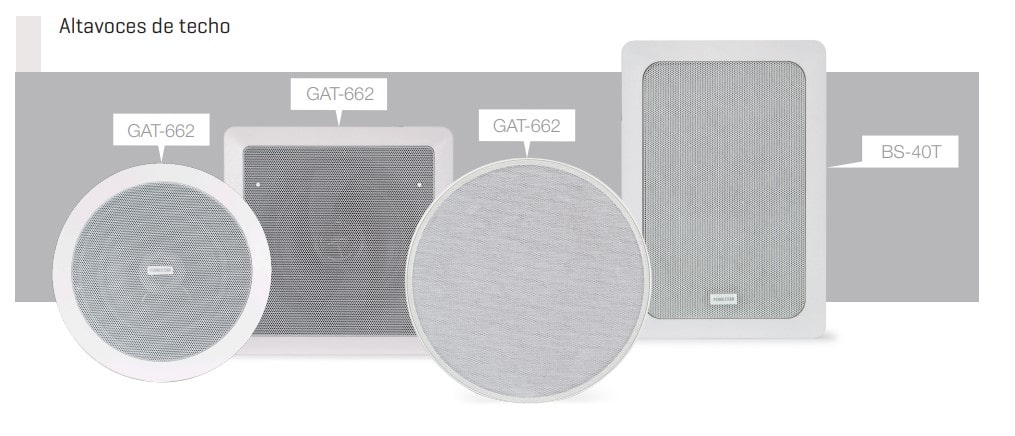
In large venues, especially if the ceilings are high, covered with very poorly absorbent materials, there are usually problems of reverberation, so that speech can become intelligible due to an accumulation of refl ected signals. This is the case in most churches, where it is recommended to use sound columns installed on the walls or rafters in the case of analogue columns, or in the speaker’s area towards the audience in the case of digital columns. The sound columns concentrate the sound emitted in the horizontal plane thanks to the internal arrangement of the speakers.
In order to avoid resonance, the columns should be installed low (the centre of the column at most 2 m from the floor) and directed towards the audience area to avoid sound dispersion. In the case of analogue columns, to avoid having to increase the volume level too much, it is recommended to increase the number of columns so that everyone in the audience has 1 or 2 columns nearby, so that they are located within the direct radiation fi eld of the loudspeakers and can be heard at low volume, thus reducing reverberation. For digital columns, placing 1 or 2 in the speaker zone will allow the sound to be concentrated in the audience zone at a distance of 30-40 m. In addition, the directivity pattern is configurable, resulting in higher quality.
There are certain types of special speakers for particularly large and resonant venues (pavilions, sports halls, naves, etc.) of the hanging sphere type. This type of speaker has a large horizontal coverage, covering large surfaces. Areas that are poorly covered can always be supplemented with projectors or small baffles.
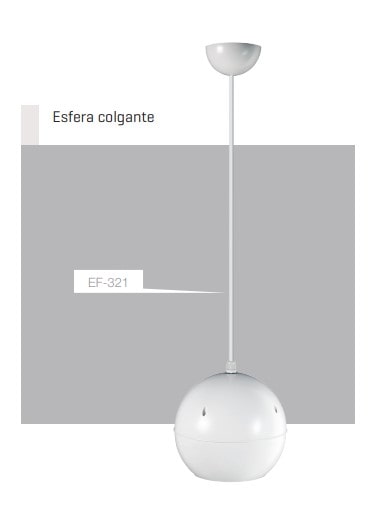
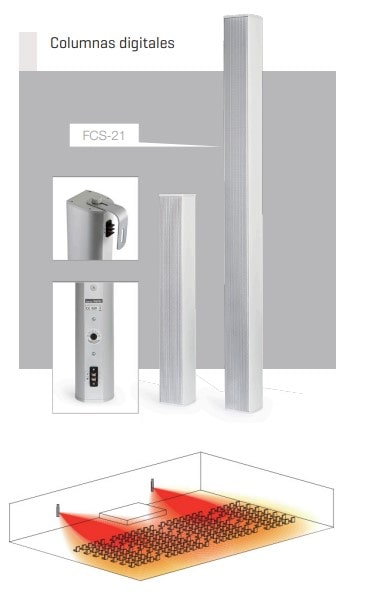
If the room is open, the general rule is to use exponential horn type loudspeakers, especially if the purpose of the installation is to carry the speech over long distances. It should be noted, when positioning the speakers, that this type of speaker is very directional. If the installation requires music quality, projectors will need to be used.
The projector is much less directional, but offers better sound quality. In addition, direct radiation speakers are less effi cient than horn speakers, so more power is required to achieve the same range.

